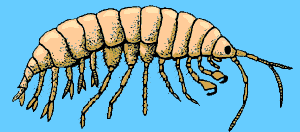|
|
Isopods and Amphipods
General
Two successful groups of Crustaceans are the Isopods and Amphipods, with about 350 - 400 thousand species in each group. Members of both groups are poor swimmers and live their lives as bottom crawlers and beach scavengers.
Features which all members of these two groups have in common are:
- lack of a carapace,
- sessile eyes, not on stalks,
- highly specialised limbs,
- respiratory pleopods, and the
- uropods not forming a tail-fan.

The Isopods
are all dorsoventrally flattened
(top = dorso) (bottom = ventrally)
with all thoracic limbs similar and all abdominal limbs similar. The common
example is the Marine Slater,
Ligia australiensis. On
rocky ocean shores, it seems to become more common, the more southerly
the shore. It always seems to be abundant in estuaries.

The Amphipods are laterally (side to side) compressed with the thoracic and abdominal limbs, each arranged in at least two groups, differing in form and function so that there are between 4 - 6 different limb sets. Sand Hoppers are the common example. They are often found under broken clumps of algae stranded on the shore, especially along southern shores.
| For more information on Crustaceans visit MESA Crustaceans |
Home
Page
Taxonomy
Biogeography
Rocky Shores
Tidal Levels
Intertidal Zonation
Environmental Factors
Biological
Factors
Feeding Relationships
Activities
Glossary
References
 Life
on Australian Seashores
Life
on Australian Seashores
by Keith Davey (C) 2000
Learning Consultant
- Media
The University of Newcastle
email at australian_seashores@hotmail.com
Scientific Consultant: Phil
Colman
site created 01.01.98 : updated 01.04.2000
